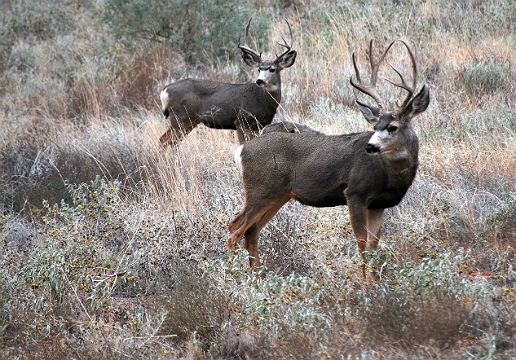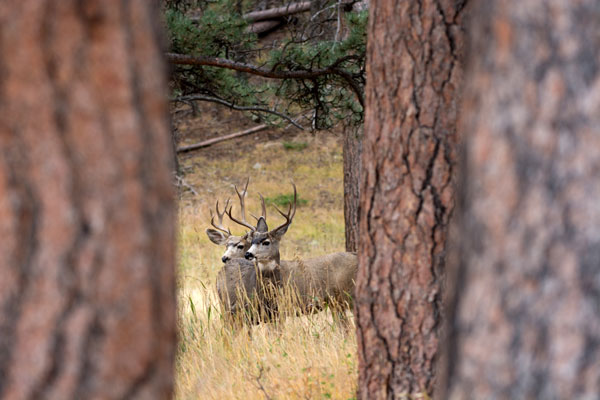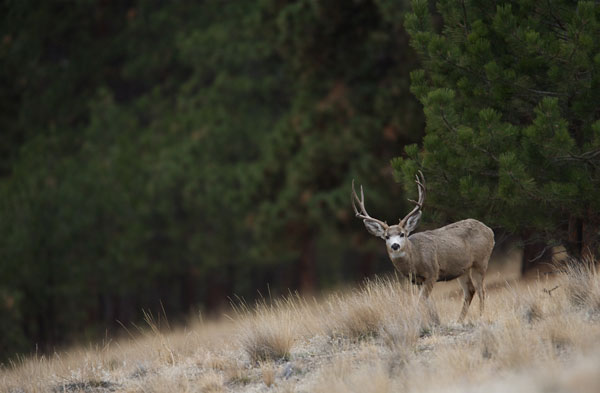How Antlers Grow
The science behind antler growth






Mule deer and white-tailed deer are the most widely distributed and abundant big game mammals in Montana. Although they evolved to live and thrive in broadly different environments, the two species are remarkably adaptive. Both occur in a wide variety of habitats, under widely fluctuating environmental conditions, in the presence of numerous other wild mammals and domestic livestock, and in the wake of extensive human development and disturbance.
Managing deer across diverse habitats and conditions in Montana begins with understanding both their biology and behavior. It also requires effective methods for monitoring populations and habitats as well as for manipulating deer numbers or habitat factors to meet diverse social and economic objectives.
Montana has a long history of research to provide basic information about deer and their habitats and to develop and test new and improved methods and criteria for deer management.
For historical harvest reports and more information, visit here.
Deer are managed as a game animal in Montana with regulated hunting seasons.
2024 Chart (PDF)
2023 Chart (PDF)
2022 Chart (PDF)
2021 Chart (PDF)
2020 Chart (PDF)
2019 Chart (PDF)
2018 Chart (PDF)
2017 Chart (PDF)
2016 Chart (PDF)
2015 Chart (PDF)
2024 Map (PDF)
2023 Map (PDF)
2022 Map (PDF)
2021 Map (PDF)
2020 Map (PDF)
2019 Map (PDF)
2018 Map (PDF)
2017 Map (PDF)
2016 Map (PDF)
2015 Map (PDF)
2024 Chart (PDF)
2023 Chart (PDF)
2022 Chart (PDF)
2021 Chart (PDF)
2020 Chart (PDF)
2019 Chart (PDF)
2018 Chart (PDF)
2017 Chart (PDF)
2016 Chart (PDF)
2015 Chart (PDF)
2014 Chart (PDF)
2013 Chart (PDF)
2012 Chart (PDF)
2011 Chart (PDF)
Mule deer population trends are of concern in Montana, where declines in abundance and hunter harvest have been documented in many areas throughout the state. Wildlife managers are tasked with the difficult mission of maintaining or recovering deer populations, dampening the magnitude of potential future declines, and stabilizing hunter opportunity. Therefore, improved quantitative understanding of mule deer dynamics is of particular relevance across Montana.
The methods by which FWP currently monitors and manages mule deer were established in 2001 with the adoption of the Adaptive Harvest Management (AHM) system (FWP 2001). This system currently includes three components: 1) population objectives, 2) monitoring program, 3) hunting regulation alternatives. FWP collects multiple sources of monitoring data to guide management decisions under the AHM system, and distinct from this current process are other vital rate data collected as part of research studies. With this project, we seek to leverage existing monitoring and research data together for an integrated quantitative assessment of mule deer dynamics for informing management. Additionally, we aim to collect novel field data in portions of northwest Montana and along the Rocky Mountain Front where biologists are faced with reduced mule deer numbers yet lack basic ecological and population information to manage with strong confidence.
2021 Final Report (PDF)
2020 Annual Report (PDF)
2019 Annual Report (PDF)
2018 Annual Report (PDF)
2017 Annual Report (PDF)
Area Wildlife Biologist, Libby
Montana Fish, Wildlife & Parks
Reasearch Biologist
Montana Fish, Wildlife & Parks
Area Wildlife Biologist, Fairfield
Montana Fish, Wildlife & Parks
Area Wildlife Biologist, Eureka
Montana Fish, Wildlife & Parks
Director, Wildlife Biology Program
University of Montana
Unit Leader, Cooperative Wildlife Research Unit
University of Montana
MS Student
University of Montana
MS Student
University of Montana
This project is a collaboration between FWP and the University of Montana. Additional financial support for this project has been provided by the Allan Foundation and a matching Federal Aid in Wildlife Restoration grant to FWP.
Mule deer populations have been on the decline recently throughout Montana and portions of the northwestern United States. Biologists throughout the region observed similar declines in mule deer populations during the late 1960s, the late 1970s, and again in the early and mid 1990s. Despite growing concern over these declines, the complex combination of factors that drive regional mule deer population fluctuations is not well understood. Potential causes include habitat loss or degradation, intraspecific competition, predation, disease, and/or interspecific competition (i.e. with elk and livestock).
In collaboration with MPG Ranch, FWP initiated a pilot study in the winter of 2015-2016 to estimate adult female mule deer survival and to identify the sources of mortality in the northern and southern Bitterroot Valley. In an effort to better understand factors that may be contributing to population declines, this project will evaluate adult female survival and spatial overlap with sympatric elk populations. In addition, this project will provide baseline information on mule deer movements, diet, health, and condition.
Mule Deer Survival in the Bitterroot Valley Progress Report: Spring 2018 (PDF)
Sapphire Bitterroot Mule Deer Project Progress Report - Spring 2017 (PDF)
Mule Deer Survival in the Bitterroot Valley Progress Report - Spring 2016 (PDF)
Wildlife Research Technician
Montana Fish, Wildlife & Parks
MPG Ranch
Wildlife Research Biologist
Montana Fish, Wildlife & Parks
Area Wildlife Biologist
Montana Fish, Wildlife & Parks
Financial support for this project has been provided by:
Funding was also provided by revenues from the sale of Montana hunting and fishing licenses and matching Federal Aid in Wildlife Restoration grants to Montana Fish, Wildlife & Parks.
Climate, habitat interactions, and mule deer resource selection on winter landscapes (PDF)
Ecology and Management of Mule Deer and White-tailed Deer in Montana (PDF)
Ecology of White-tailed Deer in the Salish Mountains, 2006 (PDF)
Potential effects of oil and gas energy development on mule deer in eastern Montana (PDF)
Survey & Inventory Protocols for Big Game in Montana – White Tailed Deer
Survey & Inventory Protocols for Big Game in Montana – Mule Deer
Hunter Surveys
2023 Summary of Research* (PDF)
Selected Results from a Resident Mule Deer Hunter Survey Conducted by Montana Fish, Wildlife & Parks in 2023
*This summary was updated Aug. 30, 2023 to reflect minor language edits
2021 CWD (PDF)
2014 Hunting Access (PDF)
2013 CWD (PDF)
Additional Reports
The science behind antler growth
